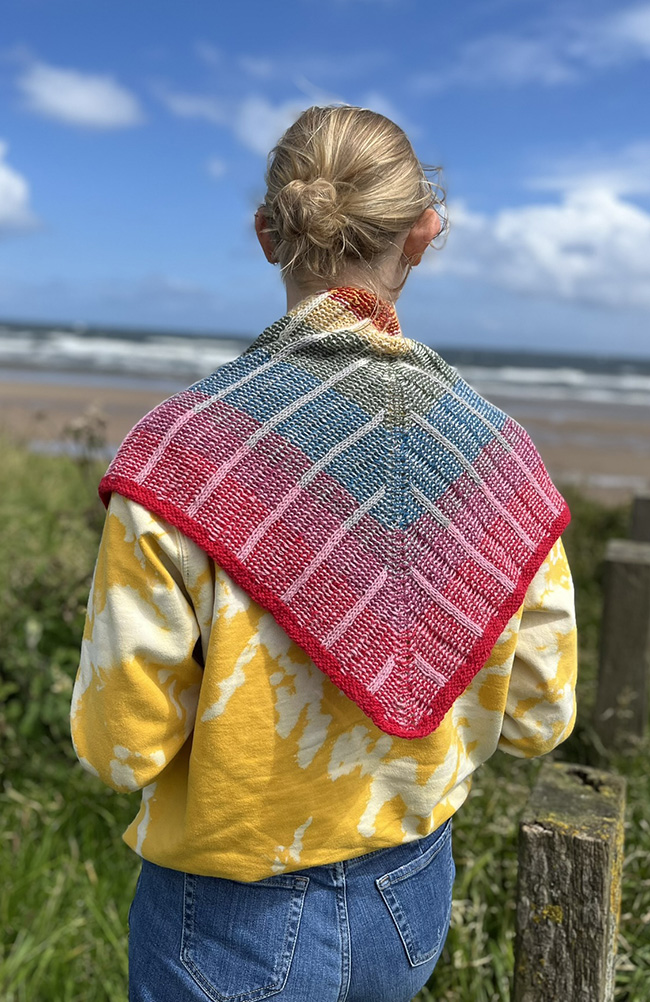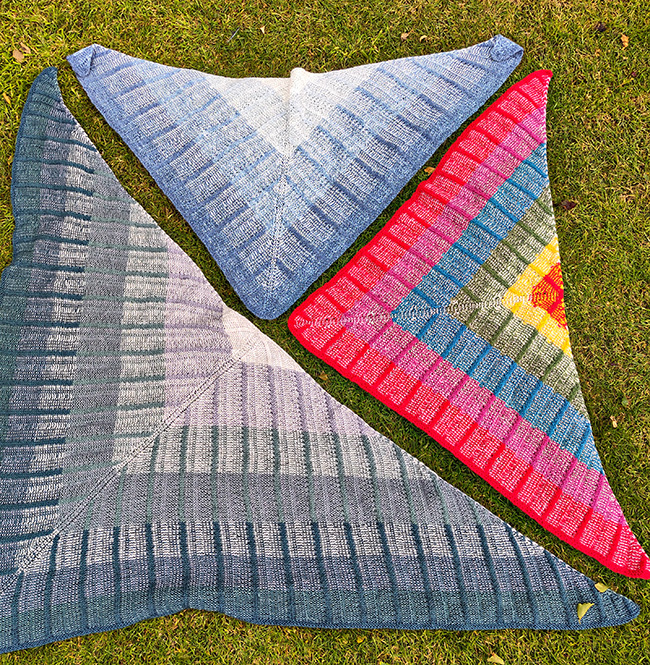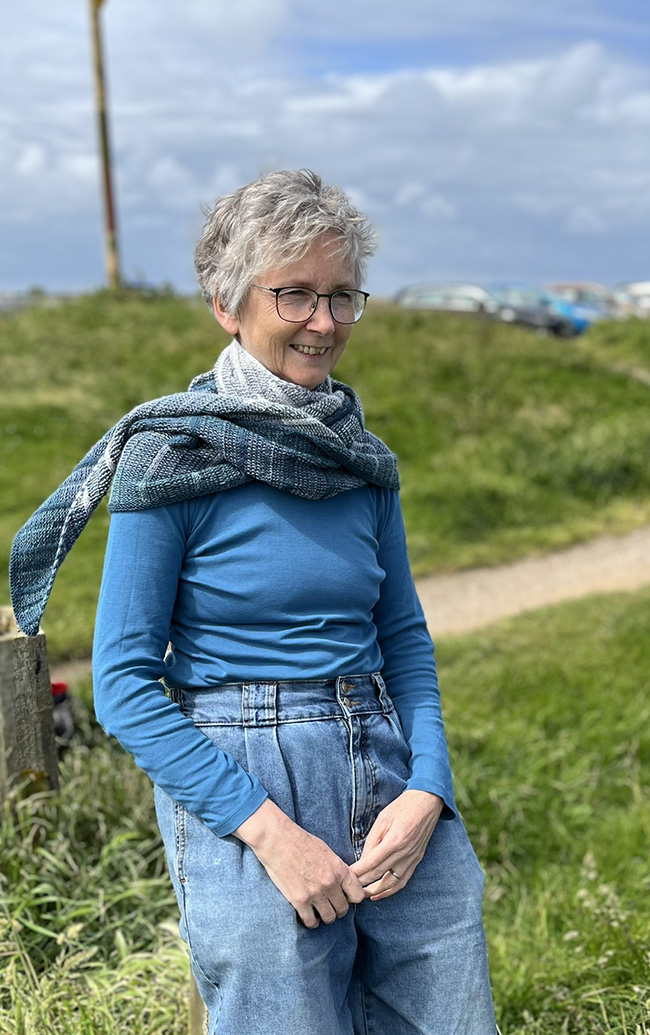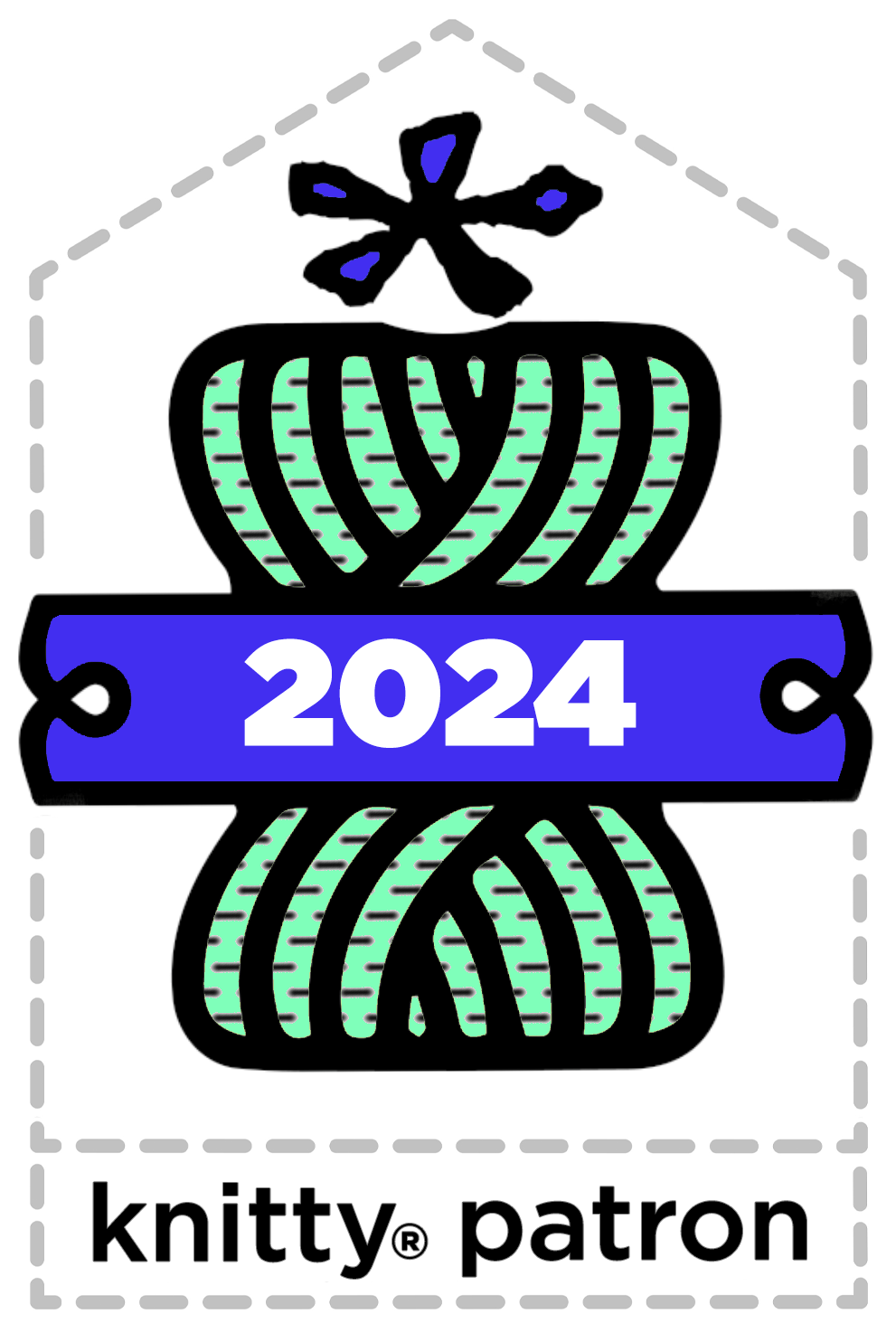Indigone, a free knitting pattern from Knitty.com.
INTRODUCTION
Indigone

by Kate Harvie
![]()
This pattern for a small shawl or necker started with a fade set of skeins of gorgeous yarn dyed with indigo by the Border Mill, which is a small spinning and dyeing business located in Duns in the Scottish Borders. The yarn was in the bargain bucket when I visited their wonderful Mill Shop. The indigo was going – going – gone! Or Indigone. This shawl is worked from the outside in, and the color gets paler as you go.
The yarn is lovely and drapey. I was concerned that it might curl unhelpfully if I made my shawl in stockinette stitch. The obvious answer was to work in garter stitch which not only lies flat naturally, but also looks equally good on both sides. The addition of lines of slipped stitches of each color adds interest and makes the item completely reversible.
I have also made a larger version. The yarn for this came from my local yarn store, and I chose it purely because it was available in a set of colors that I liked. It’s a lovely superfine superwash merino with 25% nylon.
And to complete the hat-trick, I have made a second small shawl in approximately rainbow-colored leftovers.
Because I am a bit lazy, I like it best if my rows get shorter as I go along, as it then feels that I am knitting faster. This is a triangular shawl knitted from the outside in. The colors alternate on every row, so to do this you work two right side rows, one in each color, then two wrong side rows.
 model: Kate Harvie, Jess Hayward
model: Kate Harvie, Jess Hayward
 photos: Jess Hayward, Kate Harvie
photos: Jess Hayward, Kate Harvie
SIZE
Small[Large]
shown above in Small, below in Large
FINISHED MEASUREMENTS
Wingspan: 43[67] inches/ 110[170] cm
Length: 21.5[33] inches/ 55[84] cm
MATERIALS
Yarn
Indigo (shown in Small above):
The Border Mill Alpaca and Rose 4 ply/fingering weight [50% alpaca, 50% rose fibre, 191yd/175m per 50g skein];
![]() Color A: dark indigo: 1[2] skeins
Color A: dark indigo: 1[2] skeins
![]() Color B: medium indigo: 1[2] skeins
Color B: medium indigo: 1[2] skeins
![]() Color C: light indigo: 1[2] skeins
Color C: light indigo: 1[2] skeins
![]() Color D: very pale indigo: 1[2] skeins
Color D: very pale indigo: 1[2] skeins
Note: This was a gradient set of four skeins resulting from an indigo-dyeing experiment, and there are no shade numbers or names.
Indigo (shown in Large below):
Hjertegarn Armonia fingering [75% superwash superfine merino, 25% nylon, 219yd/200m per 50g ball];
![]() Color A: shade 4316 – 1[2] balls
Color A: shade 4316 – 1[2] balls
![]() Color B: shade 4612 – 1[2] balls
Color B: shade 4612 – 1[2] balls
![]() Color C: shade 4307 – 1[2] balls
Color C: shade 4307 – 1[2] balls
![]() Color D: shade 434 – 1 ball
Color D: shade 434 – 1 ball
Rainbow shawl (shown in Small below):
Garthenor Organic Pentland fingering [100% Romney lambswool, 186yds/170m per 50g ball];
![]() Poppy (red)
Poppy (red)
![]() Almond Blossom (pale pink)
Almond Blossom (pale pink)
![]() Mulberry (deep pink)
Mulberry (deep pink)
![]() Tin (gray)
Tin (gray)
![]() Sicily (blue)
Sicily (blue)
![]() Willow (green)
Willow (green)
![]() Butternut (yellow)
Butternut (yellow)
![]() Salt (white)
Salt (white)
These eight colors were scraps of leftovers from a previous project, which I used semi-randomly according to how much I had available. I divided the yarns into darker and lighter colors, using one of each and swapping in the next color when I either ran out or thought it was time for a change. I continued the four-row sequence throughout, except for the last three rows which were all worked in the same color.
Note: because this shawl is worked from the long edge inwards, you do need to make sure you have sufficient yarn. If making a substitution, use the yardage of each as a guide.
Estimated yardage used in the samples:
Color A – 180[364] yds/ 165[332] metres
Color B – 130[276] yds/ 119[252] metres
Color C – 119[276] yds/ 109[252] metres
Color D – 115[219] yds/ 105[200] metres
Total yarn used: 544[1135] yds/ 498[1036] metres
Yarn Characteristics
![]() The samples were all worked with 2- or 3-ply fingering-weight yarn. You can use thicker yarn with correspondingly larger needles. We recommend using solid or semi-solid yarn in at least two colors to show the slip stitch pattern best.
The samples were all worked with 2- or 3-ply fingering-weight yarn. You can use thicker yarn with correspondingly larger needles. We recommend using solid or semi-solid yarn in at least two colors to show the slip stitch pattern best.
Recommended needle size
[always use a needle size that gives you the gauge listed below - every knitter's gauge is unique]
![]() 1 US 6/4mm circular needle, at least 24 inch/60cm for small, at least 32 inch/80cm for large.
1 US 6/4mm circular needle, at least 24 inch/60cm for small, at least 32 inch/80cm for large.
Notions
![]() stitch markers
stitch markers
![]() a removable stitch marker or safety pin to mark the RS of your work
a removable stitch marker or safety pin to mark the RS of your work
![]() yarn needle
yarn needle

GAUGE
20 sts/40 rows = 4 inches/10 cm in stitch pattern after blocking.
21 sts/34 rows = 4 inches/10 cm in stockinette stitch. This is a looser gauge using a larger needle than suggested on the yarn ball bands.
Note: Gauge is not critical in this project; working at a different gauge will result in a different finished item and will change yardage requirements. See Yarn section above for estimated yardage by color.
PATTERN NOTES
[Knitty's list of standard abbreviations and techniques can be found here.]
Construction method: This triangular shawl is worked from the bottom up with decreases on alternate rows. It starts with a long cast on, a garter stitch border and then the slip stitch pattern is worked with a slipped stitch edging which becomes the long edge of the triangle. The last few stitches are bound off in the middle of the long edge.
To adjust size: Small or large sizes can be made by adding pattern repeats on each side. Add or remove stitches in multiples of 48 (24 on each side). Or work the shawl in thicker or finer yarn at a different gauge, adjusting the needle size to produce the desired fabric (see below).
Slipping sts: all stitches should be slipped purlwise; instructions will indicate whether yarn is held to RS or WS or work when slipping.

CHARTS
View and download CHARTs here:
Setup and body rows, and chart key | final section (small) | final section (large)
DIRECTIONS

Using long-tail cast-on, or your preferred technique and Color A, CO 314[506] sts.
Knit 4 rows.
Place a safety pin or locking stitch marker on the RS of your work – this will make it easier to see where you are in the pattern for the first few rows.
Pattern set-up rows
Work Set-up rows 1-8, working from Set-up Rows Chart or written instructions below. 302[494] sts at the end of this section.
Set-up row 1 [RS]: With color A, sl 2 wyib, k 154[250] , pm, p2, pm, k to end of row. Slide sts to other end of needle.
Set-up row 2 [RS]: With color B, sl2 wyib, p4, (sl2 wyib, p10) 12[20] times, sl2 wyib, p4, sm, k2, sm, p4, (sl2 wyib, p10) 12[20] times, sl2 wyib, p4, k2. Turn.
Set-up row 3 [WS]: With color A, sl2 wyif, ssp, p4, (p4, sl2 wyib, p6) 12[20] times, p2, p2tog, sm, k2, sm, ssp, p4, (p4, sl2 wyib, p6) 12[20] times, p2, p2tog, p2. Slide sts to other end of needle. 4 sts decreased; 310[502] sts.
Set-up row 4 [WS]: With color B, sl2 wyif, k3, sl2 wyif, (k10, sl2 wyif) 12[20] times, k3, sm, p2, sm, k3, sl2 wyif, (k10, sl2 wyif) 12 times, k3, p2. Turn.
Set-up row 5 [RS]: With color A, sl 2 wyib, k2tog, k1, (k6, sl2 wyif, k4) 12[20] times, k3, ssk, sm, p2, sm, k2tog, k1, (k6, sl2 wyif, k4) 12[20] times, k3, ssk, k2. Slide sts to other end of needle. 4 sts decreased; 306[498] sts.
Set-up row 6 [RS]: With color B, sl2 wyib, p2, (sl2 wyib, p10) 12[20] times, sl2 wyib, p2, sm, k2, sm, p2, (sl2 wyib, p10) 12[20] times, sl2 wyib, p2, k2. Turn.
Set-up row 7 [WS]: With color A, sl2 wyif, ssp, p2, (p4, sl2 wyib, p6) 12[20] times, p2tog, sm, k2, sm, p2, (p4, sl2 wyib, p6) 12[20] times, p2tog, p2. Slide sts to other end of needle. 4 sts decreased; 302[494] sts.
Set-up row 8 [WS]: With color B, sl2 wyif, k1, sl2 wyif, (k10, sl2 wyif) 12[20] times, k1, sm, p2, sm, k1, sl2 wyif, (k10, sl2 wyif) 12 times, k1, p2. Turn.

Body of Shawl
IMPORTANT Note – read before you continue:
The body of the shawl is worked in a four-row pattern as established: A RS row in the darker color, a RS row in the lighter color, a WS row in the darker color, a WS row in the lighter color. 4 decreases are worked on the darker color rows – one each at the start and end of the rows, and one either side of the central marker.
The first and last 2 sts are worked the same way: 2 stitches are slipped at the start of each row, and worked in stockinette stitch at the ends of the rows – that is, knit on the RS rows and purled on the WS rows. There are two patterned areas, separated by a central column of 2 stitches. The central column is worked the same way throughout, in two-color garter stitch: purled on the RS darker row, knitted on RS lighter row, knitted on WS darker row, purled on WS lighter row.
In the patterned section, continue the 2-stitch slipped stitch columns as set, working them in the same place each row. As the stitch count decreases, the stitches in the slipped stitch columns will be decreased away. If only 1 stitch of the pair remains, slip it as usual.
Body Row 1 [RS]: With darker color, sl2 wyib, k2tog, work in patt as set to 2 sts before marker, ssk, sm, p2, sm, k2tog, work in patt as set to last 4 sts, ssk, k2. Slide sts to other end of needle. 4 sts decreased.
Body Row 2 [RS]: With lighter color, sl2 wyib, work in patt as set to marker, sm, k2, sm, work in patt as set to last 2 sts, k2. Turn.
Body Row 3 [WS]: With darker color, sl2 wyif, ssp, work in patt as set to 2 sts before marker, p2tog, sm, k2, sm, ssp, work in patt as set to last 4 sts, p2tog, p2, Slide sts to other end of needle. 4 sts decreased
Body Row 4 [WS]: With lighter color, sl2 wyif, work in patt as set to marker, sm, p2, sm, work in patt as set to last 2 sts, p2.
Work this group of four rows in color pairs as follows:
Colors A and B: work Body rows 1-4 2[5] times total. 286[454] sts.
Break B, join C.
Colors A and C: work Body rows 1-4 4[7] times. 254[398] sts.
Break C, join D.
Colors A and D: work Body rows 1-4 4[7] times. 222[342] sts.
Break A and D, join B and C.
Colors B and C: work Body rows 1-4 6[10] times. 174[262] sts.
Break C, join D.
Colors B and D: work Body rows 1-4 6[10] times. 126[182] sts.
Break B, join C.
Colors C and D: work Body rows 1-4 9[14] times. 54[70] sts.
Final section
Break C and continue in D alone, working the remaining rows back and forth. Work from Final Section chart for your size, or written instructions as preferred.
Written instructions
Smaller shawl only:
Row 1 [RS]: Sl2 wyib, k2tog, k3, sl2p wyif, k10, sl2p wyif, k3, ssk, pm, p2, sm, k2tog, k3, sl2p wyif, k10, sl2p wyif, k3, ssk, k2. 50 sts.
Row 2 [WS]: Sl2 wyif, k10, sl2 wyif, k10, sm, p2, sm, k10, sl2 wyif, k10, p2.
Larger shawl only:
Row 1 [RS]: Sl2 wyib, k2tog, k7, sl2p wyif, k10, sl2 wyif, k7, ssk, sm, p2, sm, k2tog, k7, sl2p wyif, k10, sl2p wyif, k7, ssk, k2. 66 sts.
Row 2 [WS]: Sl2 wyif, k2, (sl2p wyif, k10) twice, sl2 wyif, k2, sm, p2, sm, k2, (sl2p wyif, k10) twice, sl2 wyif, k2, p2.
For both sizes:
Continue in the same manner, working decreases on RS rows and keeping continuity of slipped stitch pattern as before, until 10 sts remain on needle, ending with a WS row. Remove markers on the last row.
Final Row, both sizes [RS]: Sl2p wyib, k1, ssk, k2tog, k3. 8 sts.

FINISHING
Break yarn, leaving a 12-inch (30 cm) tail. Thread yarn end onto a tapestry needle. With RS facing, pass yarn end through rem sts from right to left, pull up tightly and fasten off securely.
Using a tapestry needle, weave in all ends neatly and securely.
Soak shawl in lukewarm water with a drop of wool wash for 20-30 minutes.
Spin in the washing machine, or roll in towels to remove excess water, then pull gently into shape on a flat surface and leave until completely dry. Do not stretch or pin.
ABOUT THE DESIGNER
 Kate has been a knitter and lover of anything woolly since childhood. She survived more than 40 years working in healthcare by playing viola, walking outdoors and knitting, hopefully not all at the same time. Since retirement in 2022, Kate has had a lot of fun trying vainly to reduce her stash, designing knitwear and playing with natural dyes in her garden shed. As well as a roomful of fiber and yarn, she has three grown-up children, a husband and a cat, and lives in North Yorkshire close to the moors and the sea.
Kate has been a knitter and lover of anything woolly since childhood. She survived more than 40 years working in healthcare by playing viola, walking outdoors and knitting, hopefully not all at the same time. Since retirement in 2022, Kate has had a lot of fun trying vainly to reduce her stash, designing knitwear and playing with natural dyes in her garden shed. As well as a roomful of fiber and yarn, she has three grown-up children, a husband and a cat, and lives in North Yorkshire close to the moors and the sea.
You can find her designer page on Ravelry.
Pattern & images © 2024 Kate Harvie










